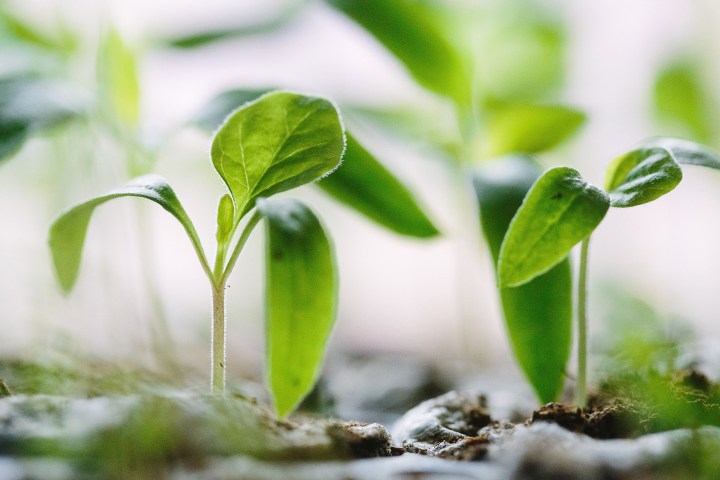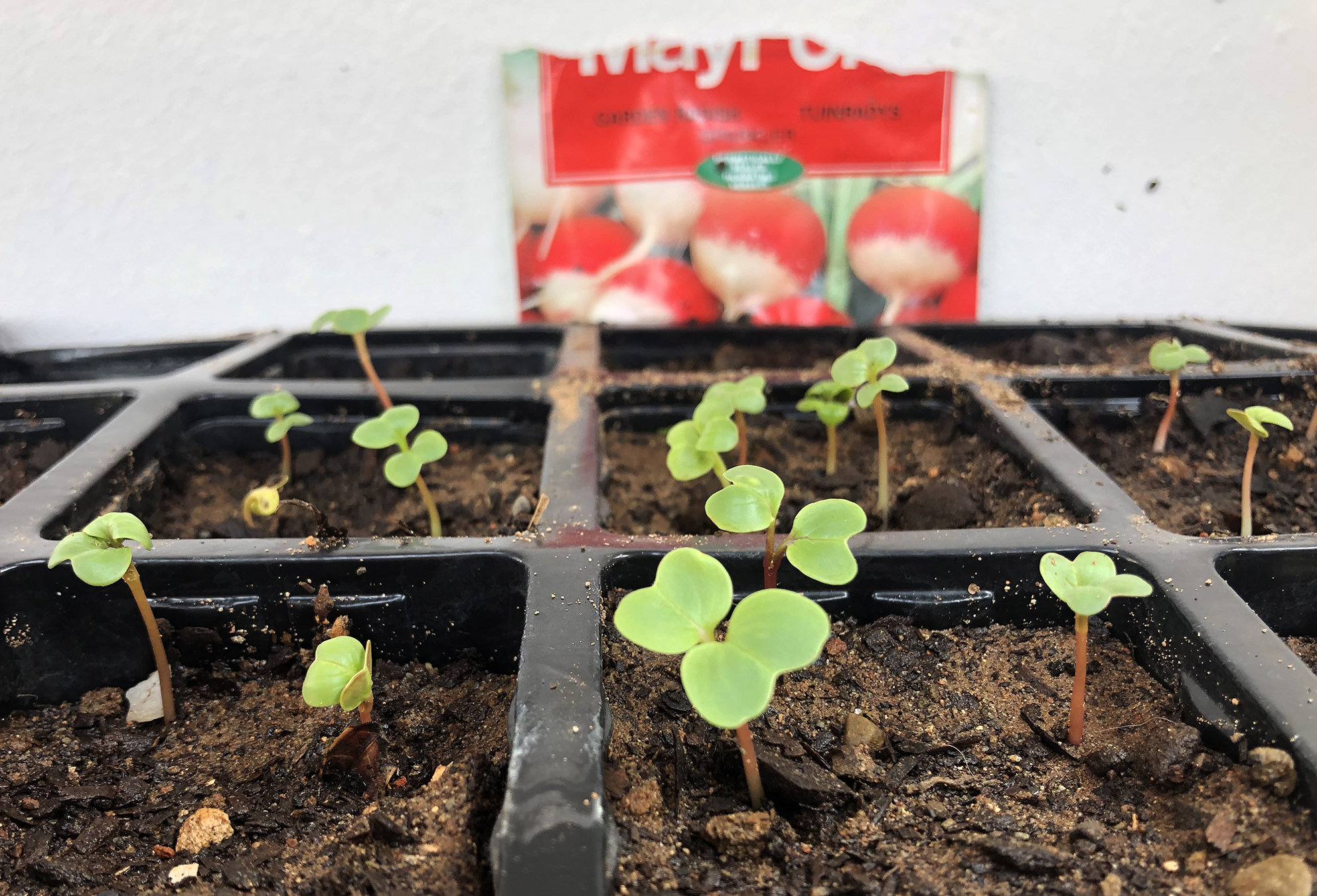GASTROTURF
Growing Gains: Out of the blue, into the green

In my mind’s eye I suddenly saw it: a room with see-through roof panels to let in enough light to grow things. The room was completed last week, last Saturday afternoon I planted seeds in trays … and the first radish shoots showed themselves only four days after I planted them.
For one who always thinks of the main ingredient on a plate as meat, I eat an awful lot of vegetables. And I’m aware that almost invariably, when faced with a plate of, say, a rib-eye steak with courgettes and gem squash, I’ll start eating the vegetables first. Without even thinking about it. I do wonder if it means something.
I first grew vegetables as a small lad. I’ve loved growing, and eating, them all my life. My dad had mapped out a vegetable garden in one section of the ground surrounding our modest bungalow in Oranjemund, where the front path was covered in pebbles which, on closer inspection, contained Tiger’s Eye, agate and even rare purple shards of amethyst. That was how your garden rolled in the diamond dorp where gemstones were just a normal part of life. They were just there, never hard to find; the sparkle in my young life.
There hadn’t even been a fence around the property when they moved in in 1952 (I wasn’t yet born). Just hard semidesert ground on which, you’d swear, nothing other than a succulent could grow. My dad proved otherwise. In the fullness of time there was an orchard with its cling peach and plum trees, pomegranate, banana and apple. In the adjacent vegetable garden there was a large bird cage with 15 green and blue budgerigars in it. The ones I got into such trouble for when I forgot to close the little door one afternoon and my dad came home from work to find they’d all fled towards the harsh semi-desert. There was a chicken coup against another fence.
Dad planted rows of runner beans, peas (and sweet peas once a year, I loved the flowers and nibbling the sweet little treasures hiding in their pods), cabbages, broccoli, cauliflower, turnips, carrots, potatoes, rhubarb, onions, and on the far side, against a fence, were his attempt at growing Brussels sprouts. A wildly successful attempt – the plants were as tall as him (well, he wasn’t a tall man, that means the plants were five foot three) and abundant with little sprouts which I’d twist and break off. And I know at least half the world will say “but why”, but they (you, perhaps) are the loser there if you haven’t eaten Brussels sprouts cooked properly, rather than have the life boiled out of them. I detest them cooked that way too.
The, shall we say, altered circumstances that beset us once we’d moved to Cape Town in 1969 meant that it would be a long time before I’d be able to grow vegetables again. As a teenager I couldn’t be bothered, and once grown up, well, you know how life takes you. There’s far too much going on in a young adult’s life to make room for nursing carrots and turnips. Our first Cape Town house, once married, had a small patch of grass and an out-of-control fig tree. The next, when my daughter was tiny, had a fair patch of ground, but all I managed were the odd daisy bush and a few forlorn tomatoes. Then, when we lived in the Tamboerskloof party house for a decade, though we had by far the biggest space we’d ever had, it was all put to paving or pool, so everything we grew was grown in pots.
Our next home was a much-reduced cottage not too far away – still in Cape Town’s City Bowl – with a slim yard at the back which was quite depressing after the Tamboerskloof space. And our three-storey rented house in Chichester, West Sussex, in the early Noughties – well, let’s say its abundant charm was offset by its postage-stamp garden. But we did manage to braai in it, even throughout four English winters, to the bemusement of our neighbours, who once called the fire brigade thinking our house was on fire.
Back in South Africa, to which we were always going to return (we didn’t “leave the country”, we went to experience life in the country of my parents’ birth), we found ourselves in Sutherland in the Karoo-Hoogland of the Northern Cape, living in one modest cottage while we turned the other into a restaurant (if you think that suggests we were rich, we paid R36k for the first, and R25k for the second – true’s Bob). Finally I was able to grow a bit of this and that, though not very successfully, given the town’s insane climate. We did have abundant rosemary, though, which was fortunate given that our little bistro specialised in Karoo lamb.
Back in Cape Town again – which brings us to circa 2008 – we found ourselves very happily back in Tamboerskloof, though in a far more humble cottage than the old house of the Nineties. But it was there that my love for growing things in pots (or in anything I could find) was rekindled, even though, again, there was nothing that wasn’t paved other than a tiny strip on the street side. The two potato plants (I mean the shrubs with the delicate blue flowers) I planted in pots are still with us now, in the front garden of our Cradock house. We took them from there to our next home, a ground-floor flat in Gardens with a back yard just big enough to make a patio of it crowded with many things growing in pots, including tomatoes and herbs.
Which means, I suppose, that it was thanks to one Iqbal Surve that I was to truly get my vegetable growing mojo back, once his machinations as the new owner of Independent Newspapers had seen off so many of us in 2014. Having fetched up in the Eastern Cape Midlands, on the edge of the lower reaches of that part of the Karoo, we were able to buy a house which had a strip of garden on each side and a big yard at the rear. The front garden (it’s actually to one side but it’s where the front door is) was lawned with a garden on the wall side, and not much in it. I planted several roses, nursed the sad-looking pair of hydrangeas that we’d inherited, put the potted potato plants in the ground, finally, and added the odd rosemary and lavender bush.
Along the opposite side went more roses, a pair of yellow daisy bushes (both now massive), and sundry odds and sods. On the far side of the house was an arid but fairly large patch of hard ground which did not seem to promise anything more than, perhaps, a few succulents and a hardy pepper tree or acacia. Being me, though, I reckon there’s no harm in trying, so thought, let’s see what will grow in it.
It is home now to an orange tree, a lemon tree, an olive that has reached rooftop height (in two and a half years), and has given us an abundance of courgettes, spinach, tomatoes, red and green peppers, chillies, broccoli, cauliflower, garlic, spring onions, leeks, gem squash, butternut, and now also has a burgeoning pomegranate tree, mirroring my childhood one.
But the real joy is what’s happening right now, and it’s as fresh as a newly sprouted pea. Having decided to turn the unused garage into a studio flat (nearly complete), for purposes of future income, and having put in a pool dam two Januaries ago, we realised that there was dead space between the garage and pool. And in my mind’s eye I suddenly saw it: a storeroom (given that we’d no longer have the garage) with see-through roof panels to let in enough light also to grow things. The room was completed last week, the shelves went up and finally my life-long ambition to have a greenhouse (sort of) has come to, dare I say it, fruition. Last Saturday afternoon I planted all sorts of seeds in trays, and I have just – right now – been out to check on them. And guess what? The first radish shoots were showing only four days after I planted them. That’s insane. But here’s the proof of it (this taken on the seventh day):

The early results of last Saturday’s soil toil. Photo: Tony Jackman
There are plenty more seeds left, so every two weeks I’ll add a few more seeds in the hope that they’ll keep turning out an ongoing harvest. And the new plan is to plant masses of seeds of peas and beetroot and whatnot, packed tightly, to grow them for microgreens. We’ll see what happens.
Look, it’s going to be hit-and-miss, of course, and I’m okay with that because my philosophy with growing things is to give anything a try because, inevitably, you’re going to win some and lose some. That’s the nature of the growing game.
But the light in the greenhouse-cum-storeroom is strong, there’s ventilation, and (it’s a storeroom, remember) if water collects on the cement floor in the hot summer months, that’s a bonus – it will favour the space with a humidity that the plants need. So when I water the trays in the morning – I hope to see the rest of the as-yet unsprouted seeds break through the earth within the next days – I leave puddles of water on the floor to evaporate during the hot part of the day.
I know this is unconventional and probably breaks all sorts of rules, and that there are professional veggie growers shaking their heads woefully, aghast at my ineptitude, but we have to have a storeroom, and anyway, most rules are there for breaking. Now I’m waiting for the basil, three types of lettuce (frilly, red oak and iceberg), celery, pak choi and coriander to show. In bigger troughs there are seedlings of Heinz tomatoes, peppers and aubergines. I’ll anchor the tomatoes later with rods, and if anything needs transplanting to the garden, I’ll always find space.
As often happens in life, it’s the unplanned things that can throw up the best surprises. We’d sworn never to live in the Karoo again. I’d long given up the idea that I’d be able to afford a garden big enough to grow my own vegetables, herbs and even citrus. Then, s#!t happens, and look, your dreams came true. Out of the blue. And into the green.
Coda
In 2018 I returned to our old house in Oranjemund and peered over the fence, 39 years after we’d left. The orchard was gone, the vegetable patch was arid nothingness. Great cement slabs had been poured where once was verdancy. The shrubs, lawns, and almost every tree except the palm my mother planted in the early Sixties, all gone, as if whoever lived there now wanted nothing green to survive. The solitary palm loomed high, a towering reminder of us. And somewhere in the baked soil must have been the forgotten seeds of long ago. Waiting for water. DM
Read more essays about random Karoo journeys, life and food in Tony Jackman’s foodSTUFF (Human & Rousseau), a cookbook-cum-memoir illustrated by 60 recipes, which was nominated for the Gourmand World Cookbook Awards (2018) in the category for best food writing. Book enquiries: [email protected]






 Become an Insider
Become an Insider